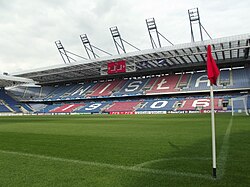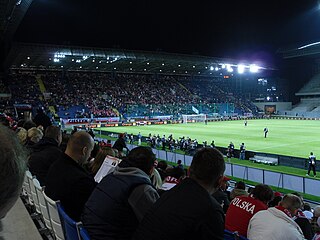
The Philips Stadion is a football stadium in Eindhoven, Netherlands. As the home of PSV Eindhoven, it is therefore also known as PSV Stadion. With a capacity of 36,500, it is the third-largest football stadium in the country. Established as the Philips Sportpark, it was constructed as a sports field for Philips employees in 1910. The Philips Elftal played football matches from 1911 until 1913, when the team was succeeded by PSV. Since 1913, PSV has used the original ground as its home stadium.

The Åråsen Stadion, officially written Åråsen stadion, is an all-seater football stadium located in Lillestrøm, a city east of Oslo in Skedsmo, Norway. With a capacity of 11,500 spectators, the venue is the home of the Eliteserien side Lillestrøm SK (LSK). The stadium has four stands, of which the West Stand has luxury boxes and club seating for 700. Because of the stadium's proximity to Kjeller Airport, it has retractable floodlights. The record attendance of 13,652 dates from 2002. In addition to league, cup and UEFA Cup matches for LSK, the venue has been used for one Strømmen IF top-league match in 1986, the UEFA Women's Euro 1997, eight other Norway women's national football team matches, the 2002 UEFA European Under-19 Football Championship, and seven Norway national under-21 football team matches.

The Estadio Olimpico Pascual Guerrero is a football stadium, also used for athletics, concerts, and rugby sevens, in Cali, Colombia. The stadium is named to honor the poet Pascual Guerrero. The stadium and the sports complex that surrounds it are one of the finest and most modern sports complexes in Latin America, and led to references of Cali as the "Sports Capital of America".
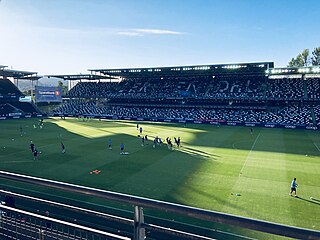
The Lerkendal Stadion is an all-seater association football stadium located at Lerkendal in Trondheim, Norway. The home ground of the Eliteserien (2017) side Rosenborg BK, it has a capacity for 21,405 spectators, making it the second-largest football stadium in the country.

Brøndby Stadium is a football stadium in Brøndbyvester, Denmark and the home ground of Danish Superliga club Brøndby IF. It is the second-largest stadium in Denmark. Built in 1965 and inaugurated on 31 July 1966 where it had no stands, it saw a major redevelopment in 2000 which increased capacity to 31,500 spectators, of which 19,700 were seated. Continuous adjustments to the spectator facilities have since resulted in the stadium having a total capacity of 29,000 spectators, of which 23,400 are seated. Record attendance dates to 18 June 2003, where a crowd of 31,508 were present in a Copenhagen Derby against F.C. Copenhagen.

The MCH Arena is an association football stadium situated in the south of Herning, Denmark, that is part of MCH Messecenter Herning complex and owned by MCH Group A/S. It has been the home ground of FC Midtjylland since March 2004. An integrated part of the arena is a main building housing the club's administration and offices for the official fan club, and includes player and referee facilities, a restaurant, a VIP lounge, press and sky boxes, and a club shop. The total capacity during domestic matches is 11,432 spectators with 7,070 seatings making it the 9th largest football stadium in Denmark. At international FIFA and UEFA matches, the capacity of the four covered single-tiered stands is reduced to 9,430, when the terraces at the north and south stands are converted to an all-seater mode. The stadium's current attendance record of 11,763 spectators dates back to a 2007–08 Danish Superliga match on 11 November 2007, when FC Midtjylland drew 2–2 against FC Copenhagen.

Odense Stadium is an association football stadium in the Bolbro district of Odense, Denmark. Nicknamed Folkets Teater by Jack Johnson, it has been the home ground of Odense Boldklub since the 1940s and has previously hosted select matches for FC Fyn (2011–2012), Boldklubben 1909, Boldklubben 1913 and Odense Boldklub Kvinde Elite during their tenures in the higher ranking leagues. With a current capacity of 15,790, it is the fifth largest football stadium of any football team in Denmark. It is part of the sports complex, known as Odense Sports Park, owned by Odense Municipality and run by the company of Odense Idrætspark.
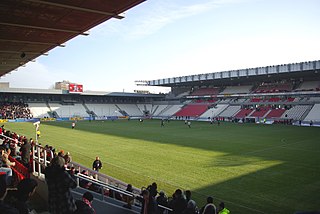
The Józef Piłsudski Cracovia Stadium is a football stadium located in Kraków, Poland. It is used mostly for football matches and it is the home ground of Cracovia and Puszcza Niepołomice. Originally, the first Cracovia stadium was built in 1912. It was demolished in mid-2009. From then until late 2010 entirely new construction was raised in roughly the same location where the old stadium stood. After reconstruction the stadium holds 15,114 people. The stadium meets the criteria for UEFA Category 3

The Stadion Poznań, also called the Municipal Stadium in Poznań and the Bulgarian Street Stadium after the road it is situated on, is an association football stadium in the Grunwald district of Poznań, Poland. It has a capacity of 42,837. The stadium was originally built between 1968 and 1980. From its inauguration in August 1980, Lech Poznań has used the ground as its main venue. It has also been used sporadically by Warta Poznań.
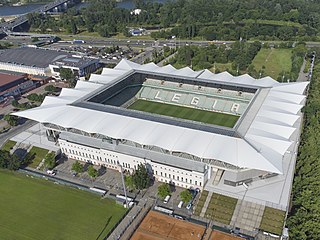
The Polish Army Stadium, official named the Marshall Józef Piłsudski Legia Warsaw Stadium, is an all-seater, highest fourth category football-specific stadium located at 3 Łazienkowska Street in the Śródmieście district, Powiśle area, within the square of the streets: Łazienkowska, Czerniakowska, Kusocińskiego and Myśliwieck. It is the home ground of Legia Warsaw football club, who have been playing there since 9 August 1930.

Sportpark Ronhof | Thomas Sommer is an association football stadium in the district of Ronhof in Fürth, Bavaria, Germany, and the home ground of 2 Bundesliga team SpVgg Greuther Fürth.

The Gdańsk Stadium, known for sponsorship reasons as the Polsat Plus Arena Gdańsk since May 2021, is a football stadium in Gdańsk, Pomeranian Voivodeship, Poland. It is used mostly for football matches and is the home stadium of Lechia Gdańsk, which competes in the Ekstraklasa. The stadium is located at the 1 Pokoleń Lechii Gdańsk Street in the northern part of the city. The total capacity is 41,620 spectators, all seated and roofed. The stadium is the second largest arena in Ekstraklasa and the third largest in the country.

The Kazimierz Górski National Stadium, known for sponsorship reasons as the PGE Narodowy since 2015, is a retractable roof football stadium located in Warsaw, Poland. It is used mostly for concerts and football matches and is the home stadium of the Poland national team.

The Wrocław Stadium, known for sponsorship reasons as the Tarczyński Arena Wrocław since 2021, is a UEFA Category Four association football stadium built for the 2012 UEFA European Football Championship. The Stadium is located on aleja Śląska in the district of Fabryczna, Wrocław. It is the home stadium of the Śląsk Wrocław football team playing in the Polish Ekstraklasa. The stadium has a capacity of 42,771 spectators, all seated and all covered.

The Białystok Stadium is located in Białystok, Poland. It is currently used mostly for association football matches and is the home ground of Jagiellonia Białystok. The stadium is also known as the Stadion Jagiellonii Białystok(English: Jagiellonia Białystok Stadium) in connection with its most common host.

Stadion Miejski im. Piotra Wieczorka w Gliwicach, also known as Stadion Piasta Gliwice, is a football-specific stadium located in Gliwice, Poland. It is the home ground of Piast Gliwice. The stadium holds 10,037 spectators. The stadium underwent a complete reconstruction which took place from September 2010 to July 2011 including the building of four new fully covered and all-seated stands.

Jagodina City Stadium, locally known as Stadion pod Đurđevim brdom, is a multi-use all-seated stadium in Jagodina, Serbia. It is currently used mostly for football matches and is the home ground of FK Jagodina. The stadium has a seating capacity for 9,977 people.
Høddvoll Stadion is a multi-sports stadium in Ulsteinvik in Ulstein, Norway. It was the home ground of 2. divisjon side IL Hødd until 2014. It is primary used for football and athletics with its all-weather running track. The stadium is a part of the sports complex consists of the Nye Høddvoll, surrounded by an all-weather running track, a natural grass training pitch and an artificial turf pitch, as well as an indoor hall. Høddvoll has a capacity for 4,433 spectators, of which 2,600 seated.

Westfalenstadion is a football stadium in Dortmund, North Rhine-Westphalia, Germany, which is the home of Borussia Dortmund. Officially called Signal Iduna Park for sponsorship reasons and BVB Stadion Dortmund in UEFA competitions, the name derives from the former Prussian province of Westphalia.
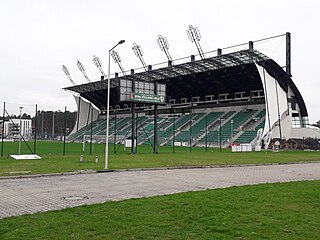
The Subcarpathian Football Center is a football training complex in Stalowa Wola, Poland, comprising a main pitch, two pitches with artificial turf, two full-size pitches, and one full-size pitch with natural grass. The main pitch serves as the home stadium for Stal Stalowa Wola. Opened in 2020, the stadium is equipped with lighting and a heated pitch, and has a seating capacity of 3,764, including 258 seats for visiting fans.
